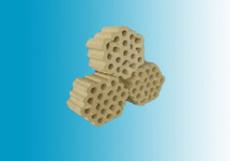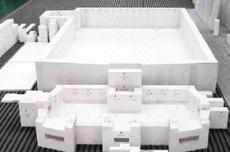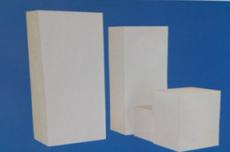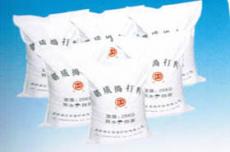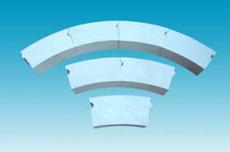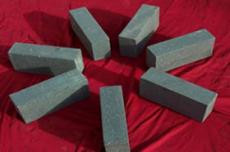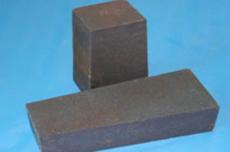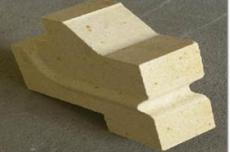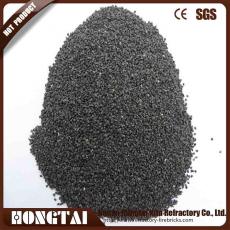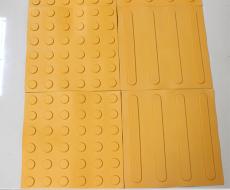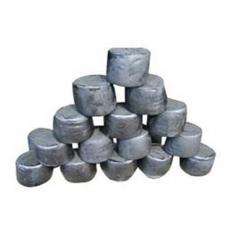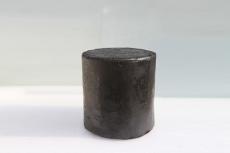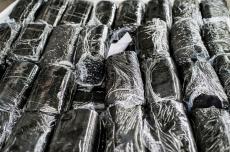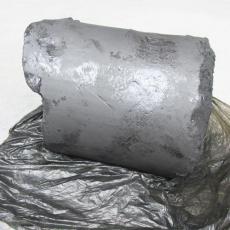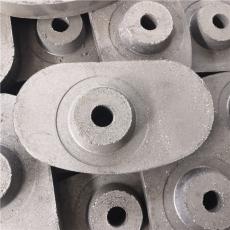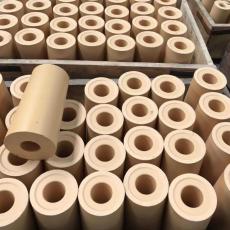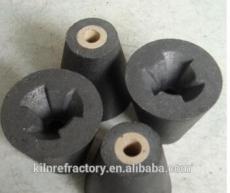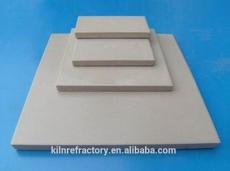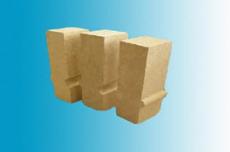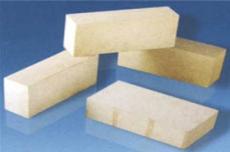
Chrome corundum platform bricks are mainly used on the push steel platform of the side-exit steel heating furnace. The use conditions of this part are harsh, including mechanical wear at high temperatures and chemical erosion. Years of practical experience have proven that general refractory materials, such as clay, high alumina, and mullite, are difficult to meet the use requirements. Only chromium corundum materials can meet such use conditions. At present, this kind of chrome corundum platform bricks are generally produced by two methods, namely the electric fusion method and the pouring and then firing method. The cost of chromium corundum bricks produced by the electrofusion method is too high and difficult for manufacturers to accept; while the latter production process is more complex and the production efficiency is low. Through many tests, our company has produced a chromium corundum brick that adopts a new production process. The chromium corundum brick produced has better high-temperature performance, and the production efficiency is greatly improved, and the production cost is greatly reduced.
1Experimental research
1.1 Selection of corundum
In order to enhance the wear resistance and corrosion resistance of this product, fused white corundum and industrial chromium oxide fine powder are selected as the main raw materials. In order to facilitate molding, the critical particle size of corundum is selected to be 5 mm, and the ratio of particles to fine powder is controlled at Around 55:45 is more suitable.
1.2 Selection of chromium oxide fine powder
In order to enhance the corrosion resistance of chromium corundum platform bricks to iron oxide at high temperatures, chromium oxide fine powder is added. Because chromium oxide has very high refractoriness and good chemical stability. Since this kind of chromium corundum brick has been used at high temperatures of about 1,300°C for a long time, it not only undergoes severe wear at high temperatures, but also chemical corrosion from molten iron oxide. Appropriately increasing the content of chromium oxide can improve the chemical corrosion resistance of the brick. . However, experiments have shown that if the amount of chromium oxide added exceeds a certain limit, it is not conducive to the sintering of bricks. It is determined that the addition amount of chromium oxide is 17% to 20%. The addition of fine powder not only improves the chemical stability of the product at high temperatures, but also has a beneficial impact on the molding and sintering of the product. The fineness requirement is less than 200 mesh and greater than 90%.
1.3 Selection of alumina fine powder
In order to improve the molding properties of the mud, as well as increase the volume density and high-temperature and room-temperature strength of the chromium corundum platform tiles, an appropriate amount of alumina ultrafine powder was added. Through many experiments, it is believed that the appropriate addition amount of alumina ultrafine powder is 5% to 10%.
1.4 Binders and additives
In order to facilitate the molding of the brick body without reducing the high-temperature performance of the chromium corundum brick, sulfurous acid pulp waste liquid was selected as the binding agent through experiments. Because in the bricks formed by the semi-dry method, especially in most of the infertile bricks, adding sulfurous acid pulp waste liquid can effectively improve the strength of the bricks and facilitate transportation and kiln installation. The specific gravity is determined to be 1.07, and the adding amount is 4 %about. Since the raw materials of bricks are barren and difficult to shape, carboxymethylcellulose was selected as the plasticizer and its addition amount was determined to be 1.5%. Because this material has greater viscosity, it will not have a negative impact on the fire resistance of the bricks.
1.5 Experimental methods
Since this kind of chrome corundum platform brick has been used at high temperatures of about 1300°C for a long time, it not only undergoes severe wear at high temperatures, but also chemical erosion by molten iron oxide. Under such conditions of use, it is necessary to extend the service life of the brick. Significant improvement, then this kind of brick must have sufficient strength at high temperatures to withstand strong mechanical wear, so the high-temperature flexural strength index of the developed test block was focused. First, mix the aggregate and fine powder evenly, then add them to a small mixer to mix with the binder, and then shape them on a 400 t friction brick press. After forming, the test block size is a standard brick of 230 mm×115 mm×65 mm. Cut these test blocks into 115 mm × 115 mm × 65 mm and 160 mm × 40 mm × 40 mm test blocks. Finally, the normal temperature compressive strength and high temperature flexural strength of this brick are tested, and the indicators of this test block are compared with the indicators of the cast test block. Through testing, the high-temperature flexural strength of cast-molded chrome corundum bricks is 0.79 MPa and 0.12 MPa, while the high-temperature flexural strength of machine-formed test blocks is 12.23 MPa, which is significantly greater than the cast-formed test blocks.
2Production process
In terms of raw material selection, fused white corundum should be a high-quality product with dense sintering and low porosity. The particle sizes are 5~3 mm, 3~1mm, and 1~0 mm. First, mix 180 mesh corundum fine powder and industrial chromium oxide fine powder. The powder is mixed with alumina fine powder and additives to prepare a mixed fine powder. The main equipment for kneading is a mixer with a roller, and its minimum rotation speed is 24r/min. The order of adding materials is to add the granular material first, stir for 1 to 2 minutes, then add about half of the binding agent, stir for about 2 minutes, and then add Mix the fine powder and stir for another 2 minutes. Finally, add the remaining binding agent and stir for about 5 minutes before discharging. The molding is carried out on a 600 t friction brick press. Due to the large volume of the bricks, the molding principle of light first and then heavy must be followed during molding. When the bricks are produced, the bricks must be handled with care to prevent damage to the brick body. The products are put into a tunnel dryer for drying. The inlet temperature of the drying medium is about 120°C, the outlet temperature is about 50~60°C, and the residual moisture after drying is controlled to less than 1%. The dried bricks are placed in the tunnel kiln for firing. The loading position is the middle and lower part of the kiln car. The maximum firing temperature of the kiln is 1500°C, and the brick body is kept for 4 hours. After firing, the brick body is dark brown.
3 applications
The produced chromium corundum platform bricks were used on-site in the heating furnace of Northwest Bearing in May 2015. The parts used were the parts with the most severe temperature and wear on the push steel platform, and were made of the same material as the chrome corundum bricks produced by a certain factory. , produced by casting molding), the performance was compared. Observation after use shows that the surface erosion degree of this brick is significantly less than that of the comparison brick, which proves that this brick has excellent wear resistance and strong resistance to iron oxide erosion, and can meet the use requirements of the steel pushing part of the heating furnace.
4 Conclusion
(1) This machine pressing molding method can produce chromium corundum bricks with relatively high strength at normal temperature and high temperature. Compared with the same type of bricks cast by casting, this kind of brick has a high volume density and uniform particle distribution, which can overcome the downward deposition of larger particles produced during casting and the tendency of more fine powder in the upper part of the brick body, making the brick The organizational structure is more uniform. (2) Because this new type of chrome corundum brick is machine-pressed, the production cycle can be greatly shortened, the production cost is significantly reduced, and the performance of this product is even better. (3) Through comparative use in heating furnaces, it can be proved that this new type of chromium corundum brick has excellent resistance to chemical erosion and wear resistance, and can fully meet the requirements of heating furnaces.
